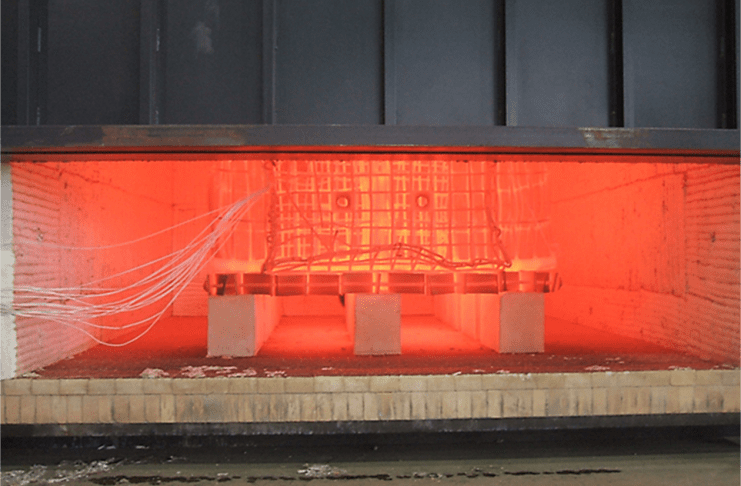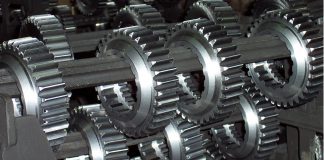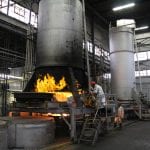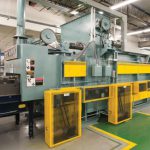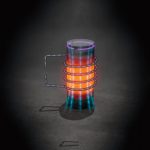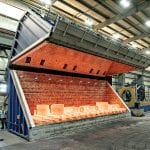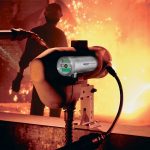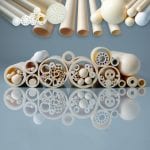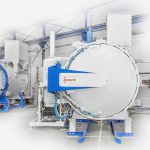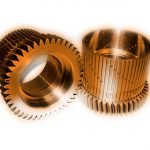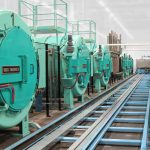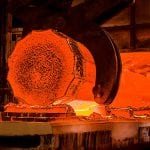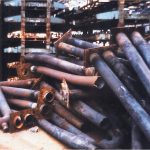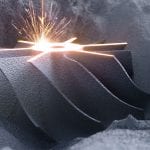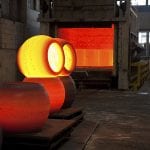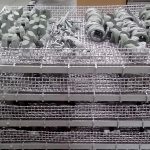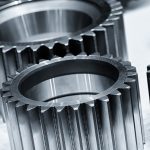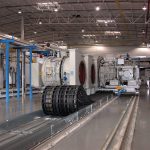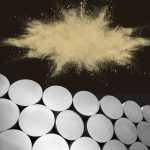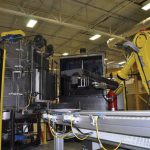A Time-Compressed Numerical Approach for Thermal Analysis of Preheating Process in Powder Metallurgy
Introduction
Recent developments have been made in the field of powder metallurgy of materials to obtain advanced properties as compared to conventional manufacturing of materials...
Rex Heat Treat
Rex Heat Treat has been involved in projects that have plumbed the depths of the Gulf and explored the landscapes of Mars, and yet,...
Case Study: SECO/Warwick and ABB Instrument Transformers
Instrument transformers are a precision device designed to accurately meter either current or voltage on an electrical circuit. They also provide a means to...
Inductive Spin Hardening of Gears: A Survey of Key Features and Benefits
A large part of the misunderstanding of induction hardening seems to stem from an incomplete grasp of the basic induction heating process. This is...
The cutting edge of thermal processing in a forge environment
Scot Forge is a 128-year-old, 100-percent employee-owned forging company that works in multiple markets from large defense, aerospace, power generation and mining projects to...
COVID-19’s effect on PRI / Nadcap
At this point in 2020, we have all felt the effects of the COVID-19 pandemic both personally and professionally. As of the writing of...
The tribology of dental ceramics
Ceramics are widely used in dentistry due to their ability to mimic the optical characteristics of enamel and dentine, as well as their biocompatibility...
What pyrometer users need to know
Radiation thermometry, also known as infrared pyrometry, optical pyrometry, or simply pyrometry, is a non-contact temperature measurement technique that requires measurement of some portion...
Improving audit performance
To add value to the aerospace suppliers who participate in Nadcap, there is an ongoing effort to do more to assist them in successfully...
Heat treatment of steel measurement of hardness and tensile strength
The heat treatment of steel changes its microstructure, its hardness, and its tensile strength. These issues are of utmost importance as they are closely...
Innovation for saving energy and improving output
The harsh economic climate of 2020 had a direct impact upon ferrous and non-ferrous metal producers, as well as those companies involved in the...
Heat work to the fore
Sporting its new tagline — Enabling a Clean, Efficient & Electrified Future — the highly regarded Ceramics Expo will once again head for Cleveland’s...
Optimizing Case-Depth Uniformity in the Vacuum Carburizing Process
Over the past few decades, the vacuum carburizing process has been proven to produce superior part quality. In addition, the use of vacuum technology...
New Simulation Software Tool Successfully Used in Carburizing Gears
In 1999 when the Center for Heat Treat Excellence (CHTE) was formed, the idea was to develop collaborative research between the industrial sector and...
Simulation of Gas Quenching of Steel Parts
One major difference between immersion quenching and gas quenching is the presence of boiling during the early stages of quenching in oil or water....
Nitrocarburizing Gears Using the ZeroFlow Method in Large-Volume Production
Retort-based nitriding and ferritic nitrocarburizing have been around a long time. Modern day challenges include providing known, repeatable hardness and surface case structures with...
Low pressure carburization modeling with carbide formation and dissociation
Low pressure carburization (LPC) processes are becoming more widespread throughout industry due to the reduced cycle times and the control over the carbon profile...
Performance and Properties of a new Alternative Gear Steel
In the ongoing strive for light weighting or power densification, high-performance clean steels are showing a significant improvement. As a next step, gear steels...
Case study: Determining the cause of cracking using computer modeling
During an induction-hardening process, the part surface is heated using a medium- to high-frequency inductor. Once the desired depth of austenitization is reached, the...
Operational efficiencies and minimizing energy consumption: An introduction
Energy conservation is the prevention of the wasteful use of energy. In today’s economic and climate-change environment, regulations and competition for resources require industrial...
Cures for Heat Treaters Headaches
Heat treaters all over the world encounter similar problems with atmosphere furnaces. These problems not only cause operational headaches in the daily lives of...
Properties of Cases Treated with High-Temperature Vacuum Carburization
Carburizing continues to be one of the basic thermochemical treatments used for industrial steel. With the development of the industry, carburizing has evolved from...
Heat Treatments and Critical Quenching Rates in Additively Manufactured Al–Si–Mg Alloys
Laser powder-bed fusion (LPBF) has significantly gained in importance and has become one of the major fabrication techniques within metal additive manufacturing. The fast...
Ensuring Effective Furnace Lining Efficiency
Refractory engineers remain under constant pressure to increase the performance of furnaces, incinerators, and reactors to maximize energy efficiency. Although there are many materials...
The future of kiln lining fibers
Lining iron and steel furnaces is critical to extend the life of the furnaces and to protect the purity of the metals being heat...
Elemental Analysis of Metal Powders and Metal Parts Produced by Additive Manufacturing
An integral part of industrial product development is the manufacture of prototypes and initial samples, regardless of whether the product is a simple screw...
Preventing eutectic reactions and diffusion bonding in vacuum processing
The purpose of this article is to explain reactions that can occur during a vacuum processing cycle and different methods of preventing these reactions....
Optimizing process operations
In integrated control system is the most effective way to enhance any complex industrial manufacturing process. A well-designed control system not only ensures greater...
Carburized steel mechanical properties: Case tensile strength
Editor’s note » This is part one of a three-part series on carburized steel mechanical properties.
Carburizing is a mature heat-treating process commonly used for...
Increased Productivity Combining C/C Fixturing and LPC
Carbon/carbon and graphite materials are used in a variety of applications throughout the high temperature furnace industry. Entire vacuum hot zones are manufactured from...
A posteriori reconstruction of the temperature distribution in surface hardened tempering steel
Process control in surface hardening depends greatly on the repeatability of the results. Induction heating facilities stand out in this aspect but challenges arise...
Combustion behavior and mechanism of Ti14 titanium alloy
The combustion behavior and mechanism of Ti14 titanium alloy are studied by promoted ignition combustion tests at different oxygen pressures. The burning velocity increases...
Using FAST-forge to produce near net shape forgings from surplus AM powder
Titanium alloys are used extensively in the aerospace sector due to the good combination of high strength-to-weight ratio and corrosive resistance. Many aerospace components...
Sophisticated control systems for optimal process operations
A comprehensive control system, whether designing a new controls package or updating your existing system to a new controls scheme, is the most effective...
Improving Production Safely with Integrated Heat Treat and Quenching Cell
These aspects are not just requested, but increasingly required by industrial clients looking to install new thermal systems or expand or enhance existing processes...
Reliable Vacuum Supply for Plasma Nitriding
Plasma nitriding is becoming more and more important for heat treatment.
Case study: Insights on a Nadcap accreditation
How did you first hear about Nadcap, and why did your company decide to pursue Nadcap accreditation in the first place?
Braddock Metallurgical was partnered...
Case Study: Busch LLC and Vakuum-Harterei Petter GmbH
Vakuum-Härterei Petter GmbH (VHP) based in Quickborn, Germany, is a contract hardening facility that specializes in high-quality heat treatment under vacuum. The company has...
Heat treatment of gears
Often the options of heat treat may feel pre-defined when looked at from a gear designer’s perspective. There are options, but both gear designers...
Effect of heat and cryogenic treatment on wear and toughness of HSS AISI M2
Despite the promising results obtained with cryogenic treatment of tool steels, there are still contradictions regarding its benefits, and there is no consensus regarding...










